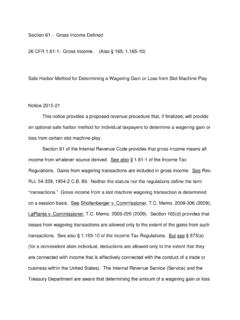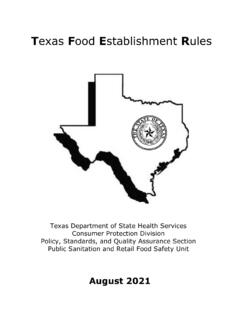Transcription of Part I Section 62.—Adjusted Gross Income Defined 26 CFR 1 ...
1 Part I Section 62. Adjusted Gross Income Defined 26 CFR : Reimbursement and other expense allowance arrangements Rev. Rul. 2005-52 ISSUE In the following situation, is the tool allowance paid by the employer to the employees paid under an accountable plan such that the payments are excluded from the employees Gross Income and exempt from the withholding and payment of employment taxes? FACTS Employer operates an automobile repair and maintenance business. Employer hires service technicians to work in the business as employees. Employer requires these employees, as a condition of employment, to provide and maintain various tools needed for use in performing repair and maintenance services. Employer pays each employee an hourly wage. In addition, Employer pays each employee a set amount for each hour worked as a tool allowance to cover costs the employee incurs for acquiring and maintaining his tools. Employer sets each employee s tool allowance annually by using a combination of data from a national survey of average tool expenses for automobile service technicians and specific information concerning tool-related expenses provided by the employee in response to an annual questionnaire completed by all service technicians who work for Employer.
2 Employer does not reimburse expenses paid or incurred for listed property, as Defined by 280F(d) of the Internal Revenue Code (the Code), or depreciation expenses; thus, these expenses are not taken into account in calculating the amount of the annual tool allowance. Employer uses the data to project the employee s total annual tool expenses. Employer then uses a projection of the total number of hours the employee is expected to work during the year that will require the use of tools to convert the employee s estimated annual tool expenses into an hourly rate for the tool allowance. Thus, the hourly tool allowance is an estimate of the tool expense projected to be incurred per hour by the employee over the course of the coming year. At the end of each pay period, each employee reports to Employer his hours worked requiring the use of tools. Employer multiplies the number of hours reported as worked requiring the use of tools by the employee s hourly rate for the tool allowance and pays the resulting amount to the employee in addition to compensation for services performed during the pay period.
3 On a quarterly statement furnished to each employee, Employer reports: (1) the amount paid to the employee as a tool allowance during the quarter, and (2) the tool expenses estimated to be incurred in the quarter ( , the hours reported worked requiring the use of tools times the tool allowance). Employees are not required to provide any substantiation of expenses actually incurred for tools either before or after the quarterly reports are issued. Employer does not require employees to return any portion of the tool allowances that exceeds the expenses they actually incur either before or after the quarterly reports are issued. LAW Section 61 of the Code provides that Gross Income means all Income from whatever source derived, including compensation for services, fees, commissions, fringe benefits, and similar items. Section 62(a)(2)(A) of the Code and (b) of the Income Tax Regulations provide that, for purposes of determining adjusted Gross Income , an employee may deduct certain business expenses paid by the employee in connection with the performance of services as an employee under a reimbursement or other expense allowance arrangement with his employer.
4 Section 62(c) provides that, for purposes of 62(a)(2)(A), an arrangement will not be treated as a reimbursement or other expense allowance arrangement if (1) the arrangement does not require the employee to substantiate the expenses covered by the arrangement to the payor, or (2) the arrangement provides the employee the right to retain any amount in excess of the substantiated expenses covered under the arrangement. Section (c)(1) of the regulations provides that a reimbursement or other expense allowance arrangement satisfies the requirements of 62(c) if it meets the requirements of business connection, substantiation, and returning amounts in excess of substantiated expenses. If an arrangement meets these requirements, all amounts paid under the arrangement are treated as paid under an accountable plan. (c)(2)(i). Amounts treated as paid under an accountable plan are excluded from the employee's Gross Income , are not required to be reported on the employee's Form W-2, and are exempt from the withholding and payment of Income and employment taxes.
5 (c)(4). If an arrangement does not satisfy one or more of these requirements, all amounts paid under the arrangement are treated as paid under a "nonaccountable plan." (c)(3). Amounts treated as paid under a nonaccountable plan are included in the employee's Gross Income , must be reported as wages or other compensation of the employee s on Form W-2, and are subject to withholding and payment of Income and employment taxes. (c)(5). Section (d)(1) provides that an arrangement meets the business connection requirements if it provides advances, allowances, or reimbursements only for business expenses that are allowable as deductions and are paid or incurred by the employee in connection with the performance of services as an employee of the employer. If, however, a payor arranges to pay an amount to an employee regardless of whether the employee incurs (or is reasonably expected to incur) bona fide employee business expenses, the arrangement does not satisfy the business connection requirements and all amounts paid under the arrangement are treated as paid under a nonaccountable plan.
6 (d)(3)(i). Section (e)(1) provides that an arrangement meets the substantiation requirements if the arrangement requires each business expense to be substantiated to the payor in accordance with paragraph (e)(3), within a reasonable period of time. An arrangement for those expenses meets the substantiation requirements of (e)(3) if information submitted to the payor is sufficient to enable the payor to identify the specific nature of each expense and to conclude that the expense is attributable to the payor s business activity. Generally the employee must submit an expense account or other written statement to the employer showing the business nature and amount of the employee s expenses. See (b)(4). Revenue Procedure 2002-41, 2002-1 1098, provides an optional expense substantiation rule applicable only to certain employers in the pipeline construction industry. If an eligible employer s arrangement to pay employee business expenses otherwise satisfies the business connection and return of excess requirements, and amounts paid under the arrangement do not exceed $ per hour, adjusted for inflation, an employee is deemed to have substantiated the expenses, and amounts paid under the arrangement are treated as paid under an accountable plan.
7 Section (f)(1) provides that an arrangement meets the return of excess requirements if the arrangement requires the employee to return to the payor within a reasonable period of time any amount paid under the arrangement in excess of substantiated expenses. Section (f)(2) provides authority for the Commissioner to issue rules, for per diem or mileage allowances only, under which an arrangement will be treated as satisfying the return of excess requirement even though the arrangement does not require the employee to return the portion of the allowance related to days or miles of travel substantiated but that exceeds the amount of the employee's expenses deemed substantiated pursuant to rules prescribed under 274(d). Section (g)(2)(ii) provides that if a payor provides employees with a periodic statement, no less frequently than quarterly, stating the amount, if any, paid under the arrangement that exceeds the expenses the employee has substantiated as required by the arrangement, and requesting the employee to substantiate any additional business expenses that have not yet been substantiated (whether or not such expenses relate to the expenses to which the original advance was paid) and/or to return any amounts remaining unsubstantiated within 120 days of the statement, an expense substantiated or an amount returned within that period will be treated as being substantiated or returned within a reasonable period of time.
8 Additionally, (k) provides that if a payor's reimbursement or other expense allowance arrangement evidences a pattern of abuse of the rules of 62(c) and the regulations thereunder, all payments made under the arrangement will be treated as made under a nonaccountable plan. ANALYSIS An amount paid by an employer to an employee to cover expenses incurred by the employee in the course of employment can be excluded from the employee s Income and wages only if a particular Code Section provides an exclusion for such amount or if the amount is paid under an accountable plan. No specific Section of the Code excludes from wages amounts paid to employees for acquiring and maintaining tools used in the performance of services as employees. Thus, to be excluded from wages, amounts paid to employees to cover expenses incurred to acquire or maintain such tools must be paid under a reimbursement or other expense allowance arrangement that meets the requirements of 62(c).
9 An arrangement qualifies as an accountable plan only if it satisfies all three requirements set forth in the statute and regulations. An arrangement that fails to meet one or more of the three requirements will be treated as a nonaccountable plan. The arrangement described in this revenue ruling fails to meet both the substantiation and the return of excess requirements and thus does not qualify as an accountable plan. Although reasonable expectations for expenses can be used to establish that a plan meets the business connection requirement, satisfaction of the substantiation and return of excess requirements must be based on expenses actually incurred. The arrangement in the facts of this ruling does not require employees to substantiate the actual expenses they are incurring; rather the employees report their time worked requiring the use of tools, and Employer converts the hours into an amount treated as expenses incurred based on statistical data. Reporting hours worked requiring the use of tools is not the equivalent of substantiating actual expenses incurred.
10 Employers may not substitute a reasonable estimate of expenses to be incurred based on statistical data and hours worked for the substantiation of actual expenses that is required by (e)(3) absent explicit guidance permitting the use of such deemed substantiation. See, , Rev. Proc. 2002-41. Employer does not cure the absence of substantiation or return of excess by providing employees with the quarterly statement described in this revenue ruling. Employer does not require employees to provide substantiation of expenses actually incurred nor does Employer require employees to return any excess received within a reasonable period of time after receiving the quarterly statement. Thus, Employer is not providing a periodic statement within the meaning of (g)(2)(ii). Each of the accountable plan requirements must be independently satisfied. Thus, even if Employer required the employees to substantiate the actual amount of the expenses, and Employer treated any portion of the tool allowances they receive that exceeded substantiated expenses as additional wages, the arrangement would still not be an accountable plan.














